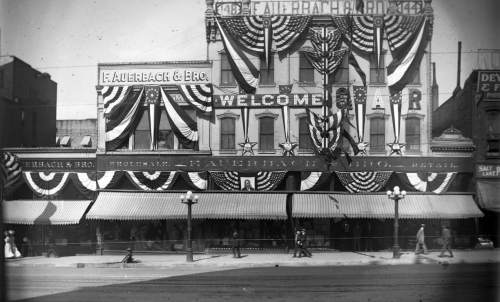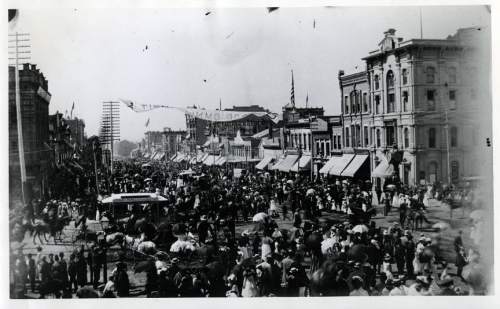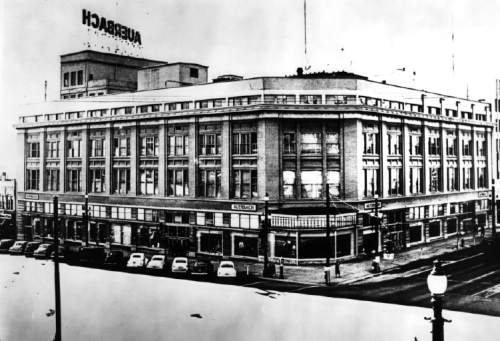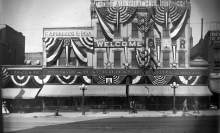This is an archived article that was published on sltrib.com in 2016, and information in the article may be outdated. It is provided only for personal research purposes and may not be reprinted.
Editor's note • In this regular series, The Tribune explores the once-favorite places of Utahns, from restaurants to recreation to retail. If you have a spot you'd like us to explore, email whateverhappenedto@sltrib.com with your ideas.
In the post-World War II era and throughout the 1960s, Auerbach's department store, at the corner of Broadway and State in Salt Lake City, stood out as a destination where shoppers — particularly women — could go to feel like they were someplace sophisticated.
Julie Burns recalled the wonder of Auerbach's on a post at the Department Store Museum website.
"To a little girl in the '50s and '60s, that store was a dream," she said. "The plush carpets, the pillars, the stunningly beautiful women who worked in the Crystal Room. Even an elevator girl!"
And during the holidays, the experience was magnified, according to Nanette Wagner's post.
"Oh how I loved Auerbach's first floor at Christmastime! The hustle and bustle of everyone, walking through the doors into cosmetics, beautifully decorated for the holidays is one of my favorite memories," she said. "I loved going to Auerbach's, my grandma, Merle Conners, worked there for years in Ladies Dresses. ... There were always Auerbach's boxes under our Christmas tree — and I have one small Auerbach box that belonged to my grandma that I have kept — it's a treasure!"
There also was a lot going on behind the scenes, recalled Brett Fossett in his post.
"I worked at Auerbach's back in the 1960s, and the most important part of Auerbach's success was the employees," he said, recalling such things as the fur vault, the window displays and the employee cafeteria, where tongues wagged over coffee and lunch about epic romances and tragic ones. There were "memorable moments ... gripes, satisfaction, intrigue and so on," he recalled.
The early days
Of course, Auerbach's had competition, particularly from ZCMI, located at Main and South Temple. The two magnificent department stores defined downtown Salt Lake City retail.
And both stores have rich histories, dating back to the 1860s, according to historian Eileen Hallet Stone, who writes a column for The Tribune.
Frederick Auerbach had operated a store in California during the gold rush. But by the mid-1860s, he was looking for a new location.
"Traveling by mule train and a mountain schooner filled with merchandise, Frederick Auerbach arrived [in Salt Lake City] in 1864 looking for shop space. He became acquainted with Brigham Young, president of The Church of Jesus Christ of Latter-day Saints, and with his help leased a small adobe cabin on the west side of Main Street," Hallet Stone wrote. "Frederick repaid the Mormon leader's generosity by contributing an entire stock of much-needed medicine to an ailing congregation."
Expansion and hospitality
Auerbach and his brothers, Theodore and Samuel, who had followed him, moved to a larger building on Main near 100 South and built the impressive retail establishment, F. Auerbach & Bro. They traded in furs and hides, sold gourmet salt in signature bags and cornered a market by marking down calico yardage from 80 cents to 50 cents, according to Hallet Stone's account and the writings of Samuel Auerbach, which she quoted:
"When out-of-town customers came in, it was customary to permit them to sleep in the store aisles or on the counters," Samuel Auerbach wrote. "Wearing boots and clothing, they'd sleep in blankets taken out of the stock for the night and returned after they had risen."
In the early years, business was rarely accomplished with cash. "It was mostly charge, due-bill or barter," Samuel Auerbach explained. "I remember Fred impressing upon a clerk to 'make out a charge, even if the store is burning!' "
Mormon rivals
By the late 1860s, some Mormon leaders saw an increase of non-Mormons — or gentiles — as a threat to LDS autonomy. In 1866, they instituted a boycott of non-Mormon businesses that lasted into 1869.
"Loyal Mormon customers, threatened with excommunication, shopped secretly at night by way of the back entrance because they dared not be seen," Samuel Auerbach wrote.
Auerbach's struggled, but it survived the boycott.
Historian Will Bagley finds it difficult to believe that Brigham Young would help any gentile, who, in Auerbach's case, was a Jew. Bagley noted, however, that Auerbach and other non-Mormon business owners paid a "tithe" to Brigham Young to remain on his good side.
A gentile center
Around the turn of the 20th century, non-Mormons tried to create a gentile center around the City/County Building near 400 South and State, Bagley said.
The construction of that building was spearheaded by R.N. Baskin, Salt Lake City mayor from 1892-1895, and one-time prosecutor of Brigham Young. The massive sandstone structure was designed to act as a counterweight to the Mormon Temple.
In 1912, Auerbach's moved to the northeast corner of 300 South and State.
"It made downtown a dynamic place because shoppers would walk from ZCMI to Auerbach," Bagley said.
In 1923, the department store moved again, this time kitty-corner, to the southwest corner of 300 South, where it remained until it closed in 1979 after 114 years.
Beautification and the end
"Over the years, Auerbach's provided a lot of jobs for Salt Lakers," Bagley said. "And it provided quality merchandise in a store that would compete against Mormon interests."
And sometimes more than that. Bagley's grandfather won a V-8 Ford in the store's annual raffle in the late 1930s.
But the famed department store's fate was mirrored by downtown Salt Lake City's in the 1970s, as suburbs grew and sprouted shopping malls. In 1977, the Auerbach family sold the store to Alvin Richer, who hoped to revitalize the historic site. But the economic currents pushed in a different direction.
Downtown retailers, like Auerbach's, faced competition from the new shopping centers, Bagley said. But he also maintains that the demise of downtown was helped along greatly by Salt Lake City politicians and planners who reduced parking and widened sidewalks as part of a beautification campaign for the city's core.
In 1980, the old edifice on the corner of Broadway and State got a new facade, masking the grand old department store. It reopened as an office building, where Bagley works, not far from where his mother sold lingerie.
AUERBACH'S STORE DIRECTORY
Downstairs
Tea Rooms • Snack Bar • Auerbach's Bargain Basement
Street Floor
Fine Jewelry • Jewelry • Hosiery • Slipper Bar Cosmetics • Handbags • Gloves • Scarves • Accessories • Street Floor Sportswear • Candy Corner • Camera Shop • Men's Shop • Men's Sportswear • Men's Furnishings • Men's Shoes • Town & Campus
South Mezzanine
Housewares • Hardware • Gift Wrap Desk
Second Floor
Dress Salon • Town Shop Dresses • Coat Salon • Town Shop Coats • Fur Salon • Sportswear • Foundations • Lingerie • Slimwear • Custom Fashions
Third Floor
Salt Laker Shop • Salt Laker Coats • Salt Laker Hats • Daytime Shop • Sorority Shop • Jr. Realities • Young Colony • World of Fashion • Fashion Galleria • Crystal Room • Maternity
Fourth Floor
Holiday Trim Shop • Silver • China • Glassware • Gift Shop • Gourmet Center • Notions • Domestics • Draperies • Fabrics • Wall Decor • Stereo & TV • Records & Radios • Stereo & TV • Record Bar • Books
Fifth Floor
Children's • Infant's • Girl's • Boy's Shop • Pre-Teens • Miss Teen • Children's Shoes • Toys • Sporting Goods • Stationery • Sporting Goods • Trophy Room
Source: thedepartmentstoremuseum.org











